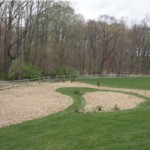*Delaware Gardener in The News Journal:
Sustainable is certainly the buzzword of the decade, but what does it mean when it comes to managing your garden? Sustainable involves letting natural systems occur and providing as few inputs as possible. We’ve already talked about one sustainable practice in Delaware Gardener this year—wait until fall to fertilize your lawn. What else can you do to manage your home landscape sustainably?
First, there is no need to go out and buy tons of new mulch every year. What can you use from your own site that will function as a mulch to keep moisture in and reduce weeds in the garden? Leaves and any other yard waste you’ve composted make great mulch. Chip up leaves that are remaining from last year with a lawn mower and spread them on your landscape beds. The first time you cut the lawn in the spring; there will probably be enough leaves in the mix so you get a nice mulching material to spread on your beds. If you’ve composted your own yard waste over the winter, it will be ready to spread this spring. You can also get composted yard waste from a variety of sources, including the City of Newark site on 896. It is free to anyone with a pick-up truck or vehicle capable of hauling mulch. You also may have enough mulch on your beds and all you need to do is use a hard rake to loosen the crust and spread it evenly over your landscape bed. Ultimately, the goal of any garden should be to have plants cover the ground so you don’t need new mulch every year. Think about the natural system of a forest—leaf litter, ground cover, shrub layer, understory trees and canopy trees make up all the layers you need in a landscape.
How is water managed on your property? Can you add trees, shrubs and groundcovers that will help take up water before it runs off your property or puddles in a low spot?
Next, think about areas of your landscape that should be lawn because you play on them, walk on them, entertain on them or need them to set off the rest of your plantings. Then look at the rest of the space on your property that might not need to be lawn. What could it be? A mini-forest or a meadow? Why not let your grass grow in some areas and cut it infrequently (once a month or once a year)? You can play around with those spaces and change them whenever you want by mowing again, if desired. Think what you could do in your garden (or elsewhere) if you didn’t need to mow an acre of lawn every week this year.
- This meadow in the back corner of a demonstration sustainable home landscape was mowed in early spring. Last year’s debris serves as a mulch to reduce weeds as he warm season grasses come up in late spring.
- Leaf clippings are used as mulch temporarily as these perennials come up and fill in this landscape bed.
Cooperative Extension has two new publications that can help you make changes in your landscape. “Livable Ecosystems: A model for suburbia” was published last summer and is available online (http://extension.udel.edu/lawngarden/files/2012/06/live_eco_final.pdf) or by calling your county extension office. The newest publication “Livable Lawns: Managing a healthy lawn” is hot off the presses and can be ordered from your county extension office or viewed online (http://extension.udel.edu/factsheet/livable-lawns-managing-a-healthy-lawn/).



